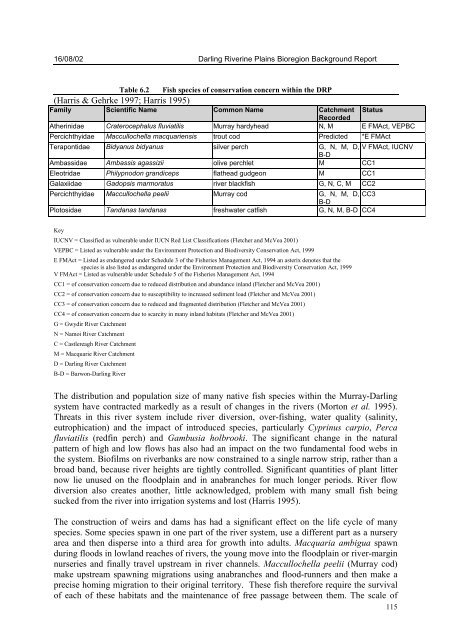DARLING RIVERINE PLAINS BIOREGION Background Report
DARLING RIVERINE PLAINS BIOREGION Background Report
DARLING RIVERINE PLAINS BIOREGION Background Report
Create successful ePaper yourself
Turn your PDF publications into a flip-book with our unique Google optimized e-Paper software.
16/08/02 Darling Riverine Plains Bioregion <strong>Background</strong> <strong>Report</strong><br />
Table 6.2 Fish species of conservation concern within the DRP<br />
(Harris & Gehrke 1997; Harris 1995)<br />
Family Scientific Name Common Name Catchment<br />
Status<br />
Atherinidae Craterocephalus fluviatilis Murray hardyhead<br />
Recorded<br />
N, M E FMAct, VEPBC<br />
Percichthyidae Maccullochella macquariensis trout cod Predicted *E FMAct<br />
Terapontidae Bidyanus bidyanus silver perch G, N, M, D, V FMAct, IUCNV<br />
B-D<br />
Ambassidae Ambassis agassizii olive perchlet M CC1<br />
Eleotridae Philypnodon grandiceps flathead gudgeon M CC1<br />
Galaxiidae Gadopsis marmoratus river blackfish G, N, C, M CC2<br />
Percichthyidae Maccullochella peelii Murray cod G, N, M, D, CC3<br />
B-D<br />
Plotosidae Tandanas tandanas freshwater catfish G, N, M, B-D CC4<br />
Key<br />
IUCNV = Classified as vulnerable under IUCN Red List Classifications (Fletcher and McVea 2001)<br />
VEPBC = Listed as vulnerable under the Environment Protection and Biodiversity Conservation Act, 1999<br />
E FMAct = Listed as endangered under Schedule 3 of the Fisheries Management Act, 1994 an asterix denotes that the<br />
species is also listed as endangered under the Environment Protection and Biodiversity Conservation Act, 1999<br />
V FMAct = Listed as vulnerable under Schedule 5 of the Fisheries Management Act, 1994<br />
CC1 = of conservation concern due to reduced distribution and abundance inland (Fletcher and McVea 2001)<br />
CC2 = of conservation concern due to susceptibility to increased sediment load (Fletcher and McVea 2001)<br />
CC3 = of conservation concern due to reduced and fragmented distribution (Fletcher and McVea 2001)<br />
CC4 = of conservation concern due to scarcity in many inland habitats (Fletcher and McVea 2001)<br />
G = Gwydir River Catchment<br />
N = Namoi River Catchment<br />
C = Castlereagh River Catchment<br />
M = Macquarie River Catchment<br />
D = Darling River Catchment<br />
B-D = Barwon-Darling River<br />
The distribution and population size of many native fish species within the Murray-Darling<br />
system have contracted markedly as a result of changes in the rivers (Morton et al. 1995).<br />
Threats in this river system include river diversion, over-fishing, water quality (salinity,<br />
eutrophication) and the impact of introduced species, particularly Cyprinus carpio, Perca<br />
fluviatilis (redfin perch) and Gambusia holbrooki. The significant change in the natural<br />
pattern of high and low flows has also had an impact on the two fundamental food webs in<br />
the system. Biofilms on riverbanks are now constrained to a single narrow strip, rather than a<br />
broad band, because river heights are tightly controlled. Significant quantities of plant litter<br />
now lie unused on the floodplain and in anabranches for much longer periods. River flow<br />
diversion also creates another, little acknowledged, problem with many small fish being<br />
sucked from the river into irrigation systems and lost (Harris 1995).<br />
The construction of weirs and dams has had a significant effect on the life cycle of many<br />
species. Some species spawn in one part of the river system, use a different part as a nursery<br />
area and then disperse into a third area for growth into adults. Macquaria ambigua spawn<br />
during floods in lowland reaches of rivers, the young move into the floodplain or river-margin<br />
nurseries and finally travel upstream in river channels. Maccullochella peelii (Murray cod)<br />
make upstream spawning migrations using anabranches and flood-runners and then make a<br />
precise homing migration to their original territory. These fish therefore require the survival<br />
of each of these habitats and the maintenance of free passage between them. The scale of<br />
115

















